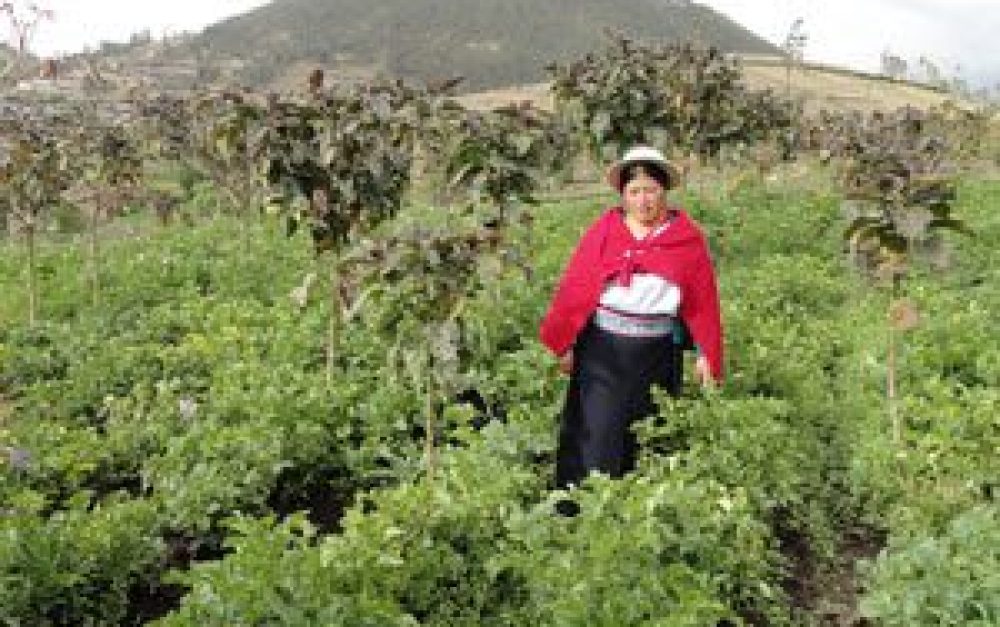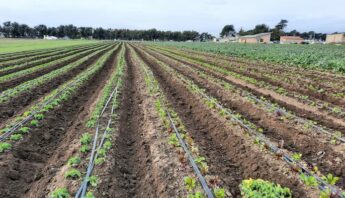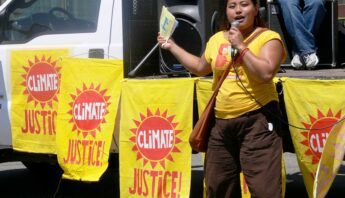As frost silvers the still-green grass outside, and I take advantage of the mild Berkeley winter to sow a small cover crop in my garden, I’m reminded that winter is a precious time of renewal and regeneration: not only in the soil and on our farms, but also within our communities and our minds.
Along those lines, I’ve been enjoying the very mind-enriching experience of reading a fascinating new book from the UK-based International Institute for Environmental Development. The forward-thinking authors of Virtuous Circles: Values, Systems and Sustainability (Michel Pimbert, Janice Jiggins and Andy Jones) take a fresh look at what we need to do to survive and thrive in the coming century.
The analysis is refreshing in its simplicity, stunning in the clarity of its logic and offers real hope on the heels of another catastrophic round of climate negotiations. It goes like this:
We must shift from today’s largely extractive linear modes of existence to sustainable circular systems.
If, at the same time, we integrate the solutions we seek across the realms of ecology, economy and society, we can respond creatively to the intersecting food, water, energy, biodiversity and climate crises that threaten us, and create a future to sustain the planet.
We know this. What’s valuable here is the economy of these two concepts juxtaposed: virtuous circles vs. vicious cycles. It’s a choice.
Linear thinking creates vicious cycles
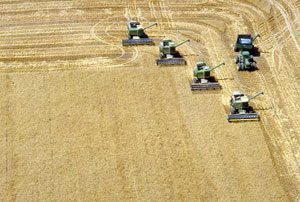 In Virtuous Circles, Pimbert et al. explain that the many devastations we see proliferating in the world around us are the direct result of the structure of today’s industrial food, energy, water and sanitation systems. The authors write:
In Virtuous Circles, Pimbert et al. explain that the many devastations we see proliferating in the world around us are the direct result of the structure of today’s industrial food, energy, water and sanitation systems. The authors write:
“These systems have a linear structure: it is assumed that at one end there is an unlimited supply of energy and raw materials (which there isn’t), while at the other the environment has an infinite capacity to absorb pollution and waste (which it can’t).
The inevitable result is resource shortages on the one hand and solid waste, climate change and air pollution problems on the other.”
The linear structure of the globalized, industrialized food system is a case in point. At first glance, we can easily see how extractive models of farming spiral into vicious cycles: they rely on an ever-increasing supply of petroleum and chemical-based inputs “from somewhere” — needed to force continued output precisely because these methods have, over time, caused the collapse of natural ecological processes on the farm — while producing a growing mountain (or deepening lagoon) of toxic waste, chemical pollution, exhausted soil, ill health and nutritional and dietary deficiencies. It’s a bad scene.
Many devastations we see proliferating in the world around us are the direct result of the structure of today’s industrial food, energy, water and sanitation systems.
When we bring to this simple picture a systems analysis and add the impact of packaging, freight transport and food waste, as well as the layered consequences of trade and aid policies, land grabs, corporate concentration and corporate influence over public policy — not only in agriculture but also in the water and energy sectors — then the downward spiral of inequitable and unsustainable outcomes gains momentum.
Add positive reinforcing feedback loops and things spin out of control: Trade agendas drive conversion of tropical forest to chemical-intensive soybean and beef production, exacerbating climate change and increasing extreme weather events across the globe, which in turn disrupt food production spurring industrialized countries, multinational corporations and sometimes philanthropic organizations to inject genetically engineered seeds and more agrichemicals into highly biodiverse fragile agroecosystems, wiping out Indigenous seeds and community knowledge of how to sustain their locally appropriate, ecologically adaptive food systems. That’s a mouthful of cascading, mutually reinforcing effects; but there’s no other way to say it without losing sight of the whole.
Connecting the dots: nature & virtuous circles
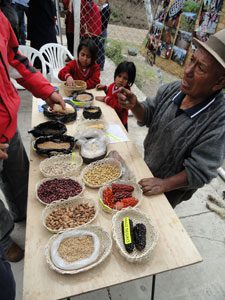 The good news is that we can apply the same systems analysis to nourish positive feedback loops that create a healthy virtuous circle. Naming this good news is what makes this book so vital.
The good news is that we can apply the same systems analysis to nourish positive feedback loops that create a healthy virtuous circle. Naming this good news is what makes this book so vital.
Two key principles highlighted by Pimbert et al. are these: natural systems are based on cycles (think of water, nitrogen and carbon) and natural systems contain very little, if any, waste. So to the extent that we design our food, water and energy systems following these principles, we can create intersecting self-sustaining virtuous circles with positive, healthy outcomes.
But we’ll have to do things differently! New concepts and approaches that will help us enormously in this transformation include ecological architecture and design, eco-communities, permaculture, agroecology, the “proximity principle” (aka “keep it local”), food sovereignty and cooperative structures. Meanwhile, the values we’ll want to highlight include ecoliteracy, equity, limits, permanence and sustainability (defined by Pimbert et al. as a dynamic adaptive process based on resilience).
Circles in practice
I always find that new concepts make the most sense when we see their practical application on the ground. My favorite example in Virtuous Circles? Farmers in the highlands of Ecuador have created a breathtakingly beautiful web of sustainable circles that has brought robust livelihoods and resilient farming systems as well as global planetary benefits.
The story begins with farmers facing severe erosion from overgrazing and deforestation for charcoal production and struggling to sustain their families. Their first step out of the vicious cycle of poverty was to create a virtuous circle focused on land restoration and water management. They started building trenches, ditches and storage pools to harvest rainwater, and planted fruit trees and crops using the saved water. Connecting to a second circle of livelihood activities, they were able to raise animals, including alpacas and llamas that provide manure for the crops and fiber for cloth. With improved soil organic matter, they increased the soil’s water and moisture retention capacity (helping to close those water and nutrient cycles). Gardens provided not only food but also flowers for bees and dyes for fabrics, hence honey and clothes for the local market, thereby invigorating their local economies while protecting ecosystem services.
But the spiraling circles do not stop at the farm gate; they engage circles of knowledge generation, innovation, organizational growth and democratic governance. Pimbert et al. explain:
These farmers have begun a process of “greening the landscape” with annual crops, perennials and reforestation in arid areas that were suffering from soil erosion and desertification…. A number of support mechanisms have been introduced, including farmer-led experimentation, farmer-to-farmer exchanges and locally managed water investment funds…. Over time, growing community technical and organizational capacities can be applied to resolving increasingly complex problems, from farm/household level concerns to community and multi-community matters.
Importantly, the efforts of these Ecuadorian farmers, along with partner organizations such as EkoRural and other actors in the alternative food movement, have spurred the on-going debates over the country’s pioneering Food Sovereignty Law.
Shifting to sustainability
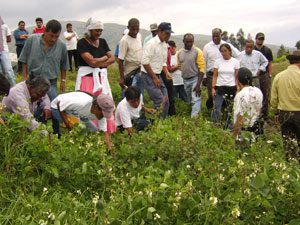 A while ago, I wrote about the crushingly disappointing conclusion to the UN climate talks in Durban, South Africa. The news that we appear to be on course for a 3 – 4º degree Celsius increase in global temperatures above pre-industrial levels — well beyond the 2ºC limit widely considered by scientists to be the maximum increase beyond which the effects of climate change will become catastrophic and irreversible — is horrifying to say the least.
A while ago, I wrote about the crushingly disappointing conclusion to the UN climate talks in Durban, South Africa. The news that we appear to be on course for a 3 – 4º degree Celsius increase in global temperatures above pre-industrial levels — well beyond the 2ºC limit widely considered by scientists to be the maximum increase beyond which the effects of climate change will become catastrophic and irreversible — is horrifying to say the least.
All the more reason that we can’t sit on our hands and leave the job of saving humanity and the planet to the world’s most marginalized and economically under-resourced (if knowledge-rich) communities. The authors of Virtuous Circles provide an abundance of well thought-out policy recommendations that can be enacted at local, national or international levels. Chief among them — and oh so relevant in the aftermath of the failed climate talks in Durban — is to develop integrated sustainable food, energy and water systems based on circular economy models that create jobs and restore ecological resilience while minimizing fossil fuel use and reducing greenhouse gas emissions.
In this deep wisdom I find reason for hope, and an idea whose elegance keeps me focused and nourished: virtuous circles indeed.
This blog was originally posted on Rodale.com Voices



